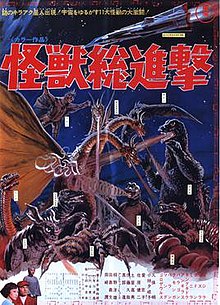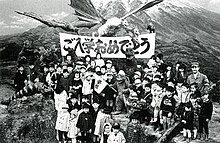Destroy All Monsters: Difference between revisions
m →References: Added book. |
Lg16spears (talk | contribs) |
||
| Line 90: | Line 90: | ||
* '''Supplements''': Audio Commentary, Image Galleries, Lobby Cards, Press Books, Poster Art, Trailers, Radio Spots, Production Art |
* '''Supplements''': Audio Commentary, Image Galleries, Lobby Cards, Press Books, Poster Art, Trailers, Radio Spots, Production Art |
||
* '''Region''' 1 |
* '''Region''' 1 |
||
==Sequel== |
|||
''[[Godzilla (2014 film)|Godzilla]]'' director [[Gareth Edwards]] has expressed an interest in making a sequel that is inspired by ''Destroy All Monsters''.<ref>{{cite web|url=http://screenrant.com/new-godzilla-movie-2014-monster-design-gareth-edwards|title=‘Godzilla’ Reboot Director Talks Creature Design; Sequel Ideas Inspired by ‘Destroy All Monsters’|publisher=ScreenRant|last=Kendrick|first=Ben|accessdate=July 25, 2013}}</ref> |
|||
==References== |
==References== |
||
Revision as of 02:11, 26 July 2013
| Destroy All Monsters | |
|---|---|
 | |
| Directed by | Ishirō Honda |
| Written by | Ishirō Honda Takeshi Kimura |
| Produced by | Tomoyuki Tanaka |
| Starring | Akira Kubo Jun Tazaki Yukiko Kobayashi Yoshio Tsuchiya Kyôko Ai Haruo Nakajima as Godzilla |
| Cinematography | Taiichi Kankura |
| Edited by | Ryohei Fujii |
| Music by | Akira Ifukube |
| Distributed by | Toho AIP |
Release dates | August 1, 1968 May 23, 1969 (US) |
Running time | 88 min |
| Languages | Japanese English (Dubbed) |
Destroy All Monsters, (released in Japan as Charge of the Monsters (怪獣総進撃, Kaijū Sōshingeki), is a 1968 Japanese Science fiction Kaiju film produced by Toho. The ninth film in the Godzilla series, it starred Akira Kubo, Jun Tazaki, Yukiko Kobayashi and Yoshio Tsuchiya. Produced in celebration as Toho's 20th Kaiju film, the film was intended to be the final Godzilla movie in the series, and as such, was given a bigger budget than the past few Godzilla productions. Set in the future, the film featured an all-star cast of monsters from many of Toho's earlier Kaiju films, eleven in all. The film was also the last to be produced by the four "Godzilla fathers", with Ishirō Honda directing, Eiji Tsuburaya supervising the special effects (with Sadamasa Arikawa actually directing), Tomoyuki Tanaka producing, and Akira Ifukube handling the film's score.
The film was released theatrically in the United States in the Spring of 1969 by American International Pictures.
Plot
At the close of the 20th century, all of the Earth's kaiju have been collected and confined in an area known as Monsterland, by the United Nations Science Committee, in the Ogasawara island chain. A special control center is constructed underneath the island to ensure the monsters stay secure, and serve as a research facility to study them.
When communications with Monsterland are suddenly and mysteriously severed, and all of the monsters begin attacking world capitals, Dr. Yoshida of the UNSC orders Captain Yamabe and the crew of his spaceship, Moonlight SY-3, to investigate Ogasawara. There, they discover that the scientists, led by Dr. Otani, have become mind-controlled slaves of a feminine alien race identifying themselves as the Kilaaks, who reveal that they are in control of the monsters. Their leader demands that the human race surrender, or face total annihilation.
Godzilla attacks New York City, Rodan invades Moscow, Mothra lays waste to Beijing, Gorosaurus destroys Paris, and Manda attacks London, which is set in to motion to take attention away from Japan, so the aliens can establish an underground stronghold near Mt. Fuji in Japan. The Kilaaks then turn their next major attack on Tokyo, and without serious opposition, become arrogant in their aims, until the UNSC discover the Kilaaks have switched to broadcasting the control signals from their base under the Moon's surface. In a desperate battle, the crew of the SY-3 destroy the Kilaak's lunar outpost and return the alien control system to Earth.
With all of the monsters under the control of the UNSC, the Kilaaks unleash their hidden weapon, King Ghidorah. The three-headed space monster is dispatched to protect the alien stronghold at Mt. Fuji, and battles Godzilla, Minilla, Mothra, Rodan, Gorosaurus, Anguirus, Kumonga, Manda, Baragon, and Varan. While seemingly invincible, King Ghidorah is eventually overpowered by the combined strength of the Earth monsters and is killed. Refusing to admit defeat, the Kilaaks produce their trump card, a burning monster they call the Fire Dragon, which begins to torch cities and destroys the control center on Ogasawara. Suddenly, Godzilla attacks and destroys the Kilaak's underground base, revealing the Earth's monsters instinctively know who their enemies are. Captain Yamabe then pursues the Fire Dragon in the SY-3, and narrowly achieves victory for the human race. The Fire Dragon is revealed to be a flaming Kilaak saucer and is destroyed. Godzilla and the other monsters are eventually returned to Monsterland to live in peace.
Cast
- Akira Kubo as Captain Katsuo Yamabe
- Jun Tazaki as Dr. Yoshido
- Yukiko Kobayashi as Kyoko Manabe
- Yoshio Tsuchiya as Dr. Otani
- Kyoko Ai as Kilaak Queen
- Andrew Hughes as Dr. Stevenson
- Kenji Sahara as Nishikawa, Moon Base Commander
Original screenplay
There was an initial screenplay with the preliminary title All Monsters Attack Directive, which would have many of the same elements used in the final product. The difference, however, was in the monster line-up. This first draft included several monsters that would appear in the final film, such as Godzilla, Mothra, King Ghidorah, Rodan, Baragon, Varan, Kumonga, and Manda. The final two monsters were Maguma (from 1962's Gorath) and Ebirah (from 1966's Godzilla vs. the Sea Monster). Maguma was to be one of the guardians of the Kilaak base with Baragon, who would have been the ones to fend off the SDF. Ebirah's role is unknown. The film’s title was later changed to Kaiju Soshingeki (Charge of the Monsters), and Ebirah and Maguma were replaced with Anguirus, Minilla (Godzilla's son) and Gorosaurus.
U.S. version

American International Pictures released the film theatrically in North America in 1969. The Americanization was handled by Titan Productions (formerly Titra Studios).
Among the changes for the U.S. release:
- Deleted: Opening credits; Moved to the end of the film and changed to white credits against a black background with the original Ifukube cue.
- Deleted: Shot of Minilla covering his eyes while King Ghidorah drops Anguirus.
In the Japanese version, the credits come right after the Moonlight SY-3 blasts off at the beginning of the movie. The American version moved the credits to the end of the picture.
This version has been replaced on home video and television by Toho's international version. While uncut and letterboxed, it features an English dub track produced by William Ross' Tokyo-based Frontier Enterprises in 1968[1].
Critical reception
Destroy All Monsters has received acclaim among Godzilla fans. The New York Times did not review the film upon release, but film critic Howard Thompson gave it a positive review on a re-release at a children's matinee with the Bugs Bunny short, Napoleon Bunny-Part, in December 1970. He commented that "the feature wasn't bad at all of this type. The trick photography and especially the blended sweep and skill of the miniature settings provided the visual splash. The human beings, with good dubbed English voices, were a personable lot as they wrestled with some outer space culprits who had rounded up Japan's favorite monsters and turned them against the planet earth."
Among modern critics, Steve Biodrowski of Cinefantastique wrote, "In the end, Destroy All Monsters is too slim in its storyline, too thin in its characterizations, to be considered a truly great film. It is not as impressive as the original Godzilla, and it is not as hip as Monster Zero. But for the ten-year-old living inside us all, it is entertainment of the most awesome sort."[2] Matt Paprocki of Blogcritics said the film is "far from perfect" and "can be downright boring at times" but felt that "the destruction scenes make up for everything else" and "the final battle is an epic that simply can't be matched".[3]
DVD releases
ADV Films
- Released: 1999
- Aspect Ratio: Widescreen (2.35:1) (non-anamorphic)
- Sound: English 2.0
- Region 1
- Note: Contains Toho's International Version; No interactive menu.
ADV Films
- Released: May 18, 2004
- Aspect Ratio: Widescreen (2.35:1) (non-anamorphic)
- Sound: English 2.0
- Supplements: CD soundtrack album
- Region 1
- Note: 50th Anniversary Edition; Includes CD soundtrack album and new cover art but film disc is identical to 1999 edition.
Media Blasters/Tokyo Shock [Note that the Media Blasters version is currently out of print.]
- Released: November 8, 2011
- Aspect Ratio: Widescreen (2.35:1)
- Sound: Japanese, English (AIP Dub), English (International Toho Dub)
- Supplements: Audio Commentary, Image Galleries, Lobby Cards, Press Books, Poster Art, Trailers, Radio Spots, Production Art
- Region 1
Sequel
Godzilla director Gareth Edwards has expressed an interest in making a sequel that is inspired by Destroy All Monsters.[4]
References
- ^ Steve Ryfle. Japan's Favourite Mon-Star. ECW Press, 1998. Pgs.152-153
- ^ Destroy All Monsters (1968) - Kaiju Review | Cinefantastique Online
- ^ Destroy All Monsters DVD Review - Blogcritics Video
- ^ Kendrick, Ben. "'Godzilla' Reboot Director Talks Creature Design; Sequel Ideas Inspired by 'Destroy All Monsters'". ScreenRant. Retrieved July 25, 2013.
- Brothers, Peter H., Mushroom Clouds and Mushroom Men - The Fantastic Cinema of Ishiro Honda (AuthorHouse 2009). http://www.amazon.com/dp/1449027717
- Thompson, Howard. Destroy All Monsters (film review). The New York Times. December 14, 1970.
Selected bibliography
- Loren Cary,Kelley Mike, Shaw Jim, "DESTROY ALL MONSTERS MAGAZINE 1976-1979",Primary Information,2011. ISBN 978-0-9788697-8-6
External links
- Godzilla on the web(Japan)
- Destroy All Monsters at IMDb
- Destroy All Monsters at Rotten Tomatoes
- "怪獣総進撃 (Kaijū Sōshingeki)" (in Japanese). Japanese Movie Database. Retrieved 2007-07-18.
- Destroy All Monsters - Toho Kingdom
- 1968 Japanese films
- 1960s science fiction films
- 1960s fantasy films
- ADV Films
- Crossover films
- Crossover tokusatsu
- Films about dragons
- Films about spiders
- Films directed by Ishirō Honda
- Films set in 1994
- Films set in Moscow
- Films set in New York City
- Films set in Paris
- Films set in the future
- Films set in Tokyo
- Films set in Yamanashi Prefecture
- Giant monster films
- Godzilla films
- Japanese-language films
- Kaiju films
- Monster movies
- Mothra
- Pterosaurs in fiction
- Sequel films
- The Moon in film
- Alien invasions in films
